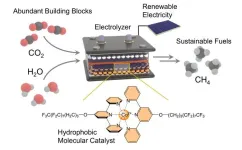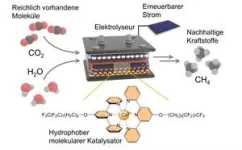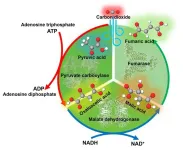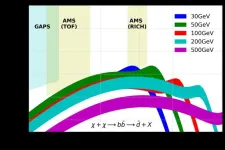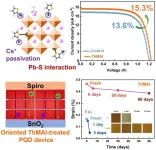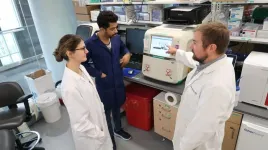(Press-News.org) Researchers at the University of Bonn and University of Montreal have developed a new type of catalyst and used it in their study to produce methane out of carbon dioxide and water in a highly efficient way using electricity. Methane can be used, for example, to heat apartments or as a starting material in the chemical industry. It is also the main component of natural gas. If it is produced using green electricity, however, it is largely climate neutral. The insights gained from the model system studied by the researchers can be transferred to large-scale technical catalysts. The system could also be used to produce other important chemical compounds. The study was recently published in the prestigious journal “Nature Chemistry.”
Many chemical reactions require energy to get started and this energy can be added by, for example, heating the reaction partners or subjecting them to high pressure. “We used electricity as the driving force instead,” explains Prof. Dr. Nikolay Kornienko. “By using climate friendly electricity, we can produce, for example, methane that doesn’t contribute to global warming.”
The researcher recently moved from the University of Montreal to the Institute of Inorganic Chemistry at the University of Bonn. He started his latest study while still in Canada and concluded it in his new home. “The production of methane – which has the chemical formula CH4 – is challenging because it is necessary to carry out a reaction between a gas and a liquid,” says Kornienko.
In this case, we are talking about carbon dioxide (CO2) and water (H2O). The researchers used a gas diffusion electrode to bring these two partners together. In the reaction, it is necessary to separate the two oxygen atoms (chemical symbol: O) from the carbon atom (C) and replace them with four hydrogen atoms (H). The hydrogen is sourced from the water.
Preventing side reactions
The problem with this process is that water would much rather undergo another reaction and will split into hydrogen and oxygen as soon as it is exposed to an electric current. “This is a competing reaction that we have to avoid,” emphasizes Kornienko’s assistant Morgan McKee, who carried out a large proportion of the experiments. “Otherwise, it would stop us producing any methane. Therefore, we have to prevent the water coming into contact with the electrode. At the same time, we still need the water as a reaction partner.”
This is where the newly developed catalyst – which is deposited onto the electrode – comes into play. It ensures above all that the carbon dioxide reacts more readily and quickly to produce methane. It achieves this with its so-called “active center” that holds the carbon dioxide and – in simple terms – also weakens the bonds between the carbon atom and the two oxygen atoms.
These oxygen atoms are then gradually replaced by four hydrogen atoms in the next step. The catalyst needs water at this stage of the process. However, it also has to keep it at a distance to avoid any undesired side reactions. “In order to achieve this, we bound long molecular side chains to the active center,” explains Prof. Kornienko, who is also a member of the Transdisciplinary Research Area “Matter” at the University of Bonn. “Their chemical structure repels water or, in other words, they are hydrophobic.”
Water-fearing molecular chains
This specialist term comes from Greek and literally means “having a fear of water.” The side chains not only keep the H2O molecules away from the active center and the electrode but they also act as a sort of conveyor belt. Figuratively speaking, they snatch hydrogen atoms from the water molecules and transport them to the active center, where they react with the carbon atom. In this way, the CO2 is converted into CH4 in several steps.
This process has an efficiency of more than 80 percent and the reaction produces hardly any undesired side products as a result. Nevertheless, the catalyst is not really suitable for the large-scale production of methane. “The reaction principles we have achieved with this catalyst could, however, be realized in other catalyst materials for use in large-scale technical applications,” says Kornienko.
The researcher believes that methane production is not the only area of application for this method. In his opinion, it could prove more lucrative in the production of other chemical compounds such as ethylene, which is used as the starting material for many plastics. In the medium term, the new catalyst method could thus be used where possible to make plastic production more environmentally friendly.
Participating institutes and funding:
The Universities of Bonn, Montreal (Canada), Swansea (Wales), Bayreuth, Oulu (Finland), Hohenheim, FU Berlin and the Synchroton SOLEIL in Saint-Aubin (France) participated in the study. The study was funded by the Natural Sciences and Engineering Research Council of Canada (NSERC), the Engineering and Physical Sciences Research Council (EPSRC), the Higher Education Funding Council for Wales (HEFCW) and the Erasmus+ programme from the EU.
Publication: Morgan McKee et. al.: Hydrophobic molecular assembly at the gas-liquid-solid interface drives highly selective CO2 electromethanation; Nature Chemistry; DOI: 10.1038/s41557-024-01650-6, URL: https://www.nature.com/articles/s41557-024-01650-6
Media contact:
Prof. Dr. Nikolay Kornienko
Institute of Inorganic Chemistry at the University of Bonn
Tel. +49 176 60999819
E-mail: nkornien@uni-bonn.de
END
Innovative catalyst produces methane using electricity
A study by the Universities of Bonn and Montreal opens up new ways to produce important chemical compounds
2024-10-04
ELSE PRESS RELEASES FROM THIS DATE:
Liver X receptor beta: a new frontier in treating depression and anxiety
2024-10-04
Houston, Texas – In a state-of-the-art Bench to Bedside review published in the journal Brain Medicine (Genomic Press), researchers Dr. Xiaoyu Song and Professor Jan-Åke Gustafsson from the University of Houston and Karolinska Institutet (Sweden) shed light on the therapeutic potential of liver X receptor beta (LXRβ) in treating depression and anxiety. This comprehensive analysis marks a significant step forward in understanding the molecular underpinnings of mental health disorders and potentially revolutionizing their treatment.
LXRβ, a nuclear receptor initially known for its role in cholesterol metabolism and inflammation, is now emerging as a crucial ...
Improving fumaric acid production efficiency through a ‘more haste, less speed’ strategy
2024-10-04
As plastic waste continues to build up faster than it can decompose, the need for biodegradable solutions is evident.
Previously, Professor Yutaka Amao and his team at Osaka Metropolitan University’s Research Center for Artificial Photosynthesis succeeded in synthesizing fumaric acid, a raw material for biodegradable plastics from biomass-derived pyruvic acid and carbon dioxide. However, the fumaric acid production process reported earlier has a problem with producing undesirable substances as byproducts in addition to L-malic acid, which is ...
How future heatwaves at sea could devastate UK marine ecosystems and fisheries
2024-10-04
The oceans are warming at an alarming rate. 2023 shattered records across the world’s oceans, and was the first time that ocean temperatures exceeded 1oC over pre-industrial levels. This led to the emergence of a series of marine heatwave events across both hemispheres, from the waters around Japan, around South America, and across the wider North Atlantic. Marine heatwaves are periods of extremely warm sea temperatures that can form in quite localized hot spots but also span large parts of ocean ...
Glimmers of antimatter to explain the "dark" part of the universe
2024-10-04
One of the great challenges of modern cosmology is to reveal the nature of dark matter. We know it exists (it constitutes over 85% of the matter in the Universe), but we have never seen it directly and still do not know what it is. A new study published in JCAP has examined traces of antimatter in the cosmos that could reveal a new class of never-before-observed particles, called WIMP (Weakly Interacting Massive Particles), which could make up dark matter. The study suggests that some recent observations ...
Kids miss out on learning to swim during pandemic, widening racial and ethnic disparities
2024-10-04
Nearly three out of four kids in Chicago had no swimming lessons in summer of 2022, with significant racial and ethnic differences, according to a parent survey from Ann & Robert H. Lurie Children’s Hospital of Chicago published in Pediatrics. Black and Hispanic/Latine kids were disproportionately affected (85 percent and 82 percent, respectively), compared to white kids (64 percent).
The most common reasons for not getting swimming lessons also differed among racial and ethnic groups. Parents of White kids reported they ...
DGIST restores the performance of quantum dot solar cells as if “flattening crumpled paper!”
2024-10-04
□ Professor Jongmin Choi’s team from the Department of Energy Science and Engineering at DGIST (President Kunwoo Lee) conducted joint research with Materials Engineering and Convergence Technology Professor Tae Kyung Lee from Gyeongsang National University and Applied Chemistry Professor Younghoon Kim from Kookmin University. The researchers developed a new method to improve both the performance and the stability of solar cells using “perovskite quantum dots.” They developed longer-lasting solar cells by addressing the issue of distortions on the surface of quantum dots, which deteriorate the ...
Hoarding disorder: ‘sensory CBT’ treatment strategy shows promise
2024-10-04
Rehearsing alternative outcomes of discarding through imagery rescripting shows promise as a treatment strategy for people who hoard, a study by UNSW psychology researchers has shown.
Hoarding disorder is a highly debilitating condition that worsens with age. People who hoard form intense emotional attachments to objects, accumulate excessive clutter, and have difficulty discarding possessions. Many avoid treatment.
People who hoard also experience more frequent, intrusive and distressing mental images in their daily lives, says Mr Isaac Sabel from the Grisham Research Lab, an experimental clinical psychology research group at UNSW Sydney.
“Negative ...
Water fluoridation less effective now than in past
2024-10-04
The dental health benefits of adding fluoride to drinking water may be smaller now than before fluoride toothpaste was widely available, an updated Cochrane review has found.
The team of researchers from the Universities of Manchester, Dundee and Aberdeen reviewed the evidence from 157 studies which compared communities that had fluoride added to their water supplies with communities that had no additional fluoride in their water. They found that the benefit of fluoridation has declined since the 1970s, when fluoride toothpaste became more widely available.
The contemporary studies were conducted in high-income countries. The impact of community water fluoridation ...
Toddlers get nearly half their calories from ultra-processed foods
2024-10-04
Toddlers in the UK obtain nearly half (47%) of their calories from ultra-processed foods (UPFs), and this rises to 59% by the age of seven, according to a new study led by UCL researchers.
The study, published in the European Journal of Nutrition, looked at data from 2,591 children born in the UK in 2007 and 2008 whose parents recorded what their children ate and drank over three days.
The most common UPFs consumed by the toddlers – who were 21 months when their parents recorded their diets – were flavoured ...
Detroit researchers to examine links between bacterial infections, environmental pollution and preterm birth
2024-10-03
DETROIT — A new grant will help Wayne State University researchers explore the links between bacterial infections, the environmental factors that increase their susceptibility and the risk of preterm birth.
The five-year, $2,858,821 grant from the National Institute of Environmental Health Sciences of the National Institutes of Health, “PFAS increases susceptibility to infection-mediated preterm birth,” will be led by Michael Petriello, Ph.D., assistant professor in Wayne State’s Institute of Environmental Health Sciences and Pharmacology in the School of Medicine.
Petriello hopes that the team’s studies will identify critical pathways responsible ...
LAST 30 PRESS RELEASES:
The Journal of Nuclear Medicine Ahead-of-Print Tip Sheet: January 2, 2026
Delayed or absent first dose of measles, mumps, and rubella vaccination
Trends in US preterm birth rates by household income and race and ethnicity
Study identifies potential biomarker linked to progression and brain inflammation in multiple sclerosis
Many mothers in Norway do not show up for postnatal check-ups
Researchers want to find out why quick clay is so unstable
Superradiant spins show teamwork at the quantum scale
Cleveland Clinic Research links tumor bacteria to immunotherapy resistance in head and neck cancer
First Editorial of 2026: Resisting AI slop
Joint ground- and space-based observations reveal Saturn-mass rogue planet
Inheritable genetic variant offers protection against blood cancer risk and progression
Pigs settled Pacific islands alongside early human voyagers
A Coral reef’s daily pulse reshapes microbes in surrounding waters
EAST Tokamak experiments exceed plasma density limit, offering new approach to fusion ignition
Groundbreaking discovery reveals Africa’s oldest cremation pyre and complex ritual practices
First breathing ‘lung-on-chip’ developed using genetically identical cells
How people moved pigs across the Pacific
Interaction of climate change and human activity and its impact on plant diversity in Qinghai-Tibet plateau
From addressing uncertainty to national strategy: an interpretation of Professor Lim Siong Guan’s views
Clinical trials on AI language model use in digestive healthcare
Scientists improve robotic visual–inertial trajectory localization accuracy using cross-modal interaction and selection techniques
Correlation between cancer cachexia and immune-related adverse events in HCC
Human adipose tissue: a new source for functional organoids
Metro lines double as freight highways during off-peak hours, Beijing study shows
Biomedical functions and applications of nanomaterials in tumor diagnosis and treatment: perspectives from ophthalmic oncology
3D imaging unveils how passivation improves perovskite solar cell performance
Enriching framework Al sites in 8-membered rings of Cu-SSZ-39 zeolite to enhance low-temperature ammonia selective catalytic reduction performance
AI-powered RNA drug development: a new frontier in therapeutics
Decoupling the HOR enhancement on PtRu: Dynamically matching interfacial water to reaction coordinates
Sulfur isn’t poisonous when it synergistically acts with phosphine in olefins hydroformylation
[Press-News.org] Innovative catalyst produces methane using electricityA study by the Universities of Bonn and Montreal opens up new ways to produce important chemical compounds
